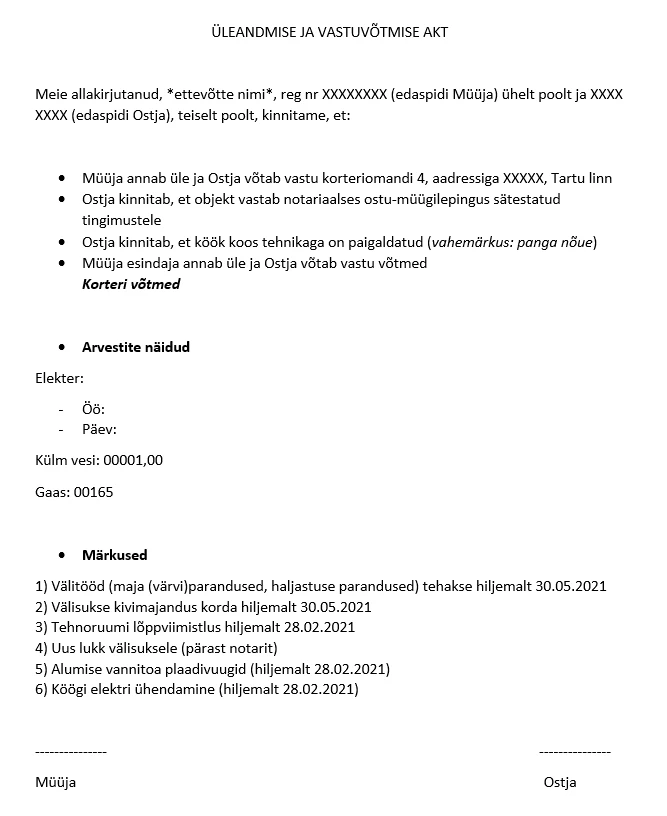Handover and Acceptance Agreement

Transfer and Acceptance Act: Importance, Common Errors, Real Act Analysis
The transfer and acceptance act is the simplest way to provide all parties with as much protection as possible in both rental and purchase-sale transactions. Kaanon Real Estate broker Annemai Tuvike provided a detailed overview of this act.
The Nature and Importance of the Transfer and Acceptance Act
Transfer and acceptance acts are simple written agreements concluded in both rental and purchase-sale transactions. All other documents, including powers of attorney, must be notarially certified when buying or selling. If real estate is purchased through a real estate agency, the real estate broker often handles the preparation of the act.
The main importance of the transfer and acceptance act lies in the fact that if, for example, there is damage to the property at the end of a rental agreement, this document can be used to determine whether it existed before the tenant moved in or not, and who bears the costs. Of course, natural wear and tear must be taken into account. If it is clear that, for example, a sofa is worn, it is not reasonable to accuse the tenant of having damaged the sofa.
Unfortunately, disputes where the parties cannot reach consensus and must go to court have become increasingly common lately. It is not excluded that in such cases there is precisely that missing act where things would have been recorded in sufficient detail so that disputes would not arise. Even if the act is missing or has deficiencies, it is always worth trying to reach agreements and find compromise outside of court. As we know, court costs and the time resources involved are often too great for it all to be worthwhile.
So the transfer and acceptance act is a good way to provide all parties with as much protection as possible. It can be used as evidence in the aforementioned court, should it really be needed. Acts eliminate or at least significantly reduce subsequent disputes or misunderstandings. This applies both to property disposition and tenant changes. If the situation is not recorded in the act, disagreements are easily created—it is the classic case of one person's word against another's.
It is gratifying to note that in recent years, the importance of acts has begun to be understood more, although they could perhaps be even more correct and thorough, depending of course on the property.
What Should Be in the Act?
Transfer and acceptance acts should definitely contain the names of the parties (the seller/landlord must be the person who is the owner according to the land register) and personal identification numbers. If the act does not contain the name and is not signed by the person who is the owner according to the land register, the act is legally null.
The act also records all possible readings (e.g., water, gas, electricity). I have also included readings in acts even when they have automatic meters.
It is also reasonable to note in the acts which keys are handed over, whether it is a property disposition or a rental object. This is especially important for rental objects, as later disputes of the style "I gave the tenant the mailbox key" are easily created if this was not noted in the act.
I have added buyer-seller phone numbers and email addresses to property disposition acts, because if the notarial copy is not printed out for the parties, then to find contact information, one must search through the eesti.ee website in a not-so-simple way for the contract (unless the buyer and seller have for some reason previously exchanged contact information). It is more sensible to therefore include contact information in the act; this way they are more readily available. At least for me, it is the more convenient option.
It is reasonable to note in the acts all deficiencies related to the property. If deficiencies are comprehensively listed in the acts, it is difficult for the buyer to say that you did not tell me about this and it is a hidden defect. In the worst case, upon the discovery of hidden defects after signing the purchase-sale agreement, the transaction can be reversed. Of course, such things are also discussed when showing and presenting the property, but written documentation is still important.
If the rental object is brand new or freshly renovated and contains, for example, expensive furniture/equipment, it is worth adding photos to the act. Real estate portal listings usually have more general photos, but the act should include specific photos of items (furniture, equipment, etc.).
In case of property disposition, it is important that the act records exactly the same items/objects (furniture, equipment, etc.) that were listed in the notarial purchase-sale agreement. The act should also include a brief description of the property's condition (if anything is broken), both for purchase-sale and rental transactions. If there are defects, cracks, holes, or any furniture damage anywhere, it is reasonable to record these as well.
It is worth noting in the act which payments and to whom remain to be paid after the agreement ends. The auxiliary costs of the last month often remain to be paid by the tenant after the rental agreement ends. For rental objects, a settlement may be made from the security deposit related to the last month's rent. The act can also note whether the landlord remains to pay the tenant the full security deposit or if some amount is deducted from it (e.g., cleaning company invoice, debt, etc.) and a smaller amount is returned.
In case of purchase-sale transactions, the act should note from what date the seller terminates contracts with service providers (water, electricity, gas, etc.) and from what date the new owner's contracts begin. In property disposition, it is also reasonable to notify the homeowners' association that possession has passed to a new owner and provide the association with the new owner's contact information.
If the property has any deficiencies that only become apparent upon property transfer, it is possible to write in the act by what deadline the landlord or seller undertakes to remedy them. There is also always the possibility of not accepting the property until the deficiencies are remedied.
For rental objects, it is therefore reasonable to conclude a transfer and acceptance act with both the new tenant coming in and the old tenant who is leaving the apartment. It is important to record in what condition the property transfers to the new tenant and also in what condition the previous tenant handed it over. It should also be noted whether the old tenant needs to compensate for any damage.
In any case, the act should not be prepared carelessly and hastily. On the contrary: the more thorough, the better.
When Is the Act Formalized?
In purchase-sale transactions, the act is formalized on the day possession passes from one owner to another. In rare cases, property has been handed over even before the contract is signed at the notary. I do not support this option, as it is not right to hand over possession to someone who is not (yet) the new owner.
For rental objects, the act is usually formalized after the rental agreement has been concluded. Keys are typically also handed over with the transfer and acceptance act. With the transfer of possession, responsibility shifts from one person to another.
Errors Made in the Act
The main problems I have noticed in connection with transfer and acceptance acts:
- the act was not signed by the property owner, but by someone who has no connection to the property whatsoever;
- deficiencies are not comprehensively listed, resulting in long and tedious word-against-word disputes;
- the actual power of attorney is missing, although it is claimed to exist.
Speaking in more detail about powers of attorney, for a purchase-sale agreement, the power of attorney must be notarial; a simple written one will not do. For a transfer and acceptance act, however, a simple written power of attorney is sufficient, as the act itself is also simple written. So the power of attorney is connected to what form the agreement takes. If the document is notarially certified, then the power of attorney must also be notarial and vice versa.
The power of attorney must be signed by the person who is actually the owner according to the land register. It cannot be that someone unrelated grants the power of attorney. In that case, the power of attorney is invalid.
Analysis of a Real Transfer and Acceptance Act
 PS. This is not a transfer and acceptance act prepared and shared by Kaanon. Namely, a person known to Kaanon recently bought themselves a home, and when accepting it, just such an act was formalized. The part of the act that was filled in by hand on site has been here retyped for readability purposes (e.g., readings and notes).
PS. This is not a transfer and acceptance act prepared and shared by Kaanon. Namely, a person known to Kaanon recently bought themselves a home, and when accepting it, just such an act was formalized. The part of the act that was filled in by hand on site has been here retyped for readability purposes (e.g., readings and notes).
COMMENTS:
- the act lacks the date on which it was formalized;
- it could be clarified whether it is a rooms/apartment or other act;
- the name and personal identification number of the board member are missing;
- it turned out that the act was signed by an authorized person, which means it should also include "… whom is represented based on a written power of attorney by …(name) …(personal identification number)";
- the purchase-sale agreement date is missing (when it was concluded);
- the act lacks a list of equipment and furniture;
- the transfer of costs from one owner to another should have been spelled out;
- the number and type of keys handed over to the buyer is not listed;
- visually it is neater if the meter readings are marked in a table;
- the electricity meters are automatic, but they should still be listed in the act for correctness;
- the fourth point in the notes (new lock): should indicate by what date it will be done;
- since the act was not signed by the owner but by an authorized person, the signature line should read "seller's representative".
Source: Kaanon Real Estate




